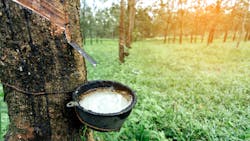If you’ve read this column for any length of time, then you know I am obsessed with the fact that tires are agricultural products. Natural rubber is a key component in every tire, some more important than others. Without it, tires will not be able to perform at the same level. I’m not a chemist or an engineer, so my knowledge of rubber compounding is rudimentary at best, but I know enough to know that nothing is more effective than natural rubber for certain performance characteristics. According to the U.S. Tire Manufacturers Association (USTMA), natural rubber comprises 34% of a truck tire, which is the most of any raw material or component. Passenger and light truck tires are 19% natural rubber, so the price of tires can be linked to the price of rubber.
The 20-year high for natural rubber prices was in February 2011, when it peaked at $6.26 per kg. Since then, the price has been steadily dropping and over the last five years, it has averaged between $1.23 and $2.71 per kg. As I write this column, the current price is $2.46, which is almost twice as much as the April 2020 price of $1.33 at the beginning of the pandemic. Recent news of increases from tire manufacturers should not come as a surprise, and taking a closer look at natural rubber production shows that more increases could be expected.
Since it’s an agricultural product, natural rubber will always be at the mercy of climate, weather, and disease. According to the Association of Natural Rubber Producing Countries (ANRPC), all three are contributors to disruptions in production, which explains the almost 10% reduction for 2020 and the resulting price increases. Their cohorts at the United Planters Association of Southern India (UPASI) also attributed the surge to a number of different factors, each of which have an impact on the global rubber market.
First, UPASI reported that China appears to be a major buyer of stock in natural rubber. With an end to the pandemic on the horizon, the World Bank is forecasting 4% growth in 2021, compared to the contraction of 4.3% for 2020. Much of that growth is being attributed to China, where strong exports are combining with government spending to speed up the Chinese economic engine. Beijing is stocking up on raw materials to lead the recovery as vaccines are being distributed around the world.
Both UPASI and ANRPC attribute travel restrictions related to the COVID-19 pandemic as a major factor for the lower production of natural rubber in 2020. It has prevented migrant tappers from Laos, Myanmar, and other border countries from physically reaching the plantations and working in the fields in Thailand and Malaysia. With vaccines a long way from reaching rubber farms in Southeast Asia, the labor shortage of tappers is expected to continue. Likewise, the ports in that region have also been hit hard by the pandemic, and this has resulted in more loading and unloading delays not to mention a container shortage.
In its November 2020 report, ANRPC identified fungal leaf disease as the reason why more than 1 million acres of mature rubber trees will have much lower yields for the next two years; leaf fall disease is a leading threat to the production of natural rubber. Similar to coronavirus, it’s difficult to spot an infected tree on sight because the disease starts at the roots. The disease, which is also known as white root disease (WRD), has been spreading across Southeast Asia without a cure.
Bridgestone recently developed technology that uses artificial intelligence (AI) and drones to merge aerial photographs and AI image analysis to work with disease experts on site to find it before it spreads. Natural rubber sustainability is a hot topic for tire manufacturers, and they are taking active steps to invest in the identification, prevention, and treatment of white root disease.
Finally, extreme weather in October and November caused additional disruptions. With most of the global natural rubber supply in a small corner of the world, environmental change is always a concern. Unlike many agricultural crops that can be modified for different climates, the Para rubber tree requires tropical temperatures and rainfall only found in a few places on Earth. Major climate changes in those regions will always be a threat to the production of natural rubber.
The effects of the 2020 pandemic that crippled so many links in the supply chain created several issues for the natural rubber market. If you can call it fortunate, the reduced demand caused by the coronavirus may have helped curb what could have been even larger price surges with production losses. While the migrant worker and port issues would not be factors, WRD and weather are immune to the effects of the pandemic, and both contributed to the current state of natural rubber.
In an industry where the supply of a key raw material is more or less finite and irreplaceable, tire manufacturers could be bracing for higher costs as the global economy rebounds in 2021. If the trend of higher natural rubber prices continues, fleets should expect more increased in tire prices across the board.
About the Author
Kevin Rohlwing
Kevin Rohlwing is the SVP of training for the Tire Industry Association. He has more than 40 years of experience in the tire industry and has created programs to help train more than 180,000 technicians.
